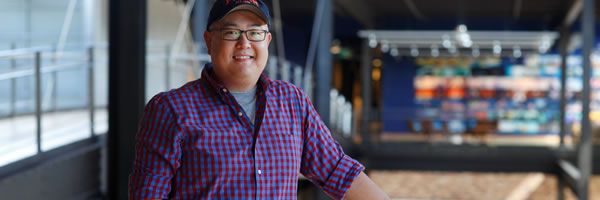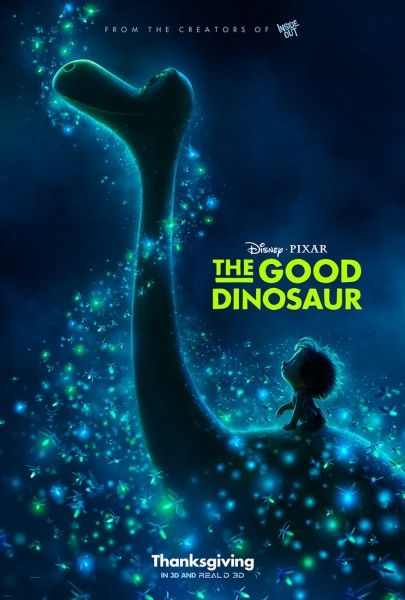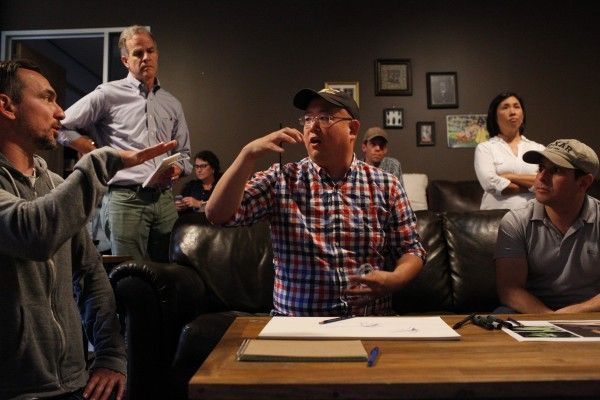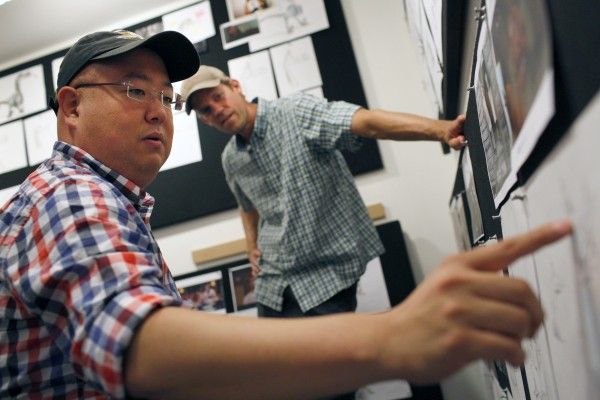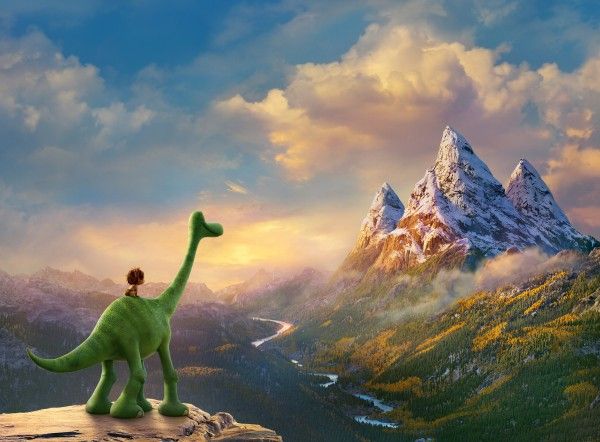During my visit to Pixar a couple months ago, I not only got to see 30 minutes of The Good Dinosaur as well as a behind-the-scenes look at the making of the film. I also got to talk with the movie’s director, Peter Sohn.
Sohn’s been with Pixar for a long time, but he wasn’t the first director to work on the movie. That was Up co-director Bob Peterson, and during my conversation with Sohn, we talked about the transition, why he came on board, how he saw the film differently, and more. We also discussed why his version of the story made the eponymous “good dinosaur” Arlo younger (Arlo was previously an “immature adult” as opposed to the 11-year-old we see in the movie), what the “good” part of the title refers to, the dichotomy between the realistic backdrops and cartoony characters, and if he sees the film as a western. If you have questions about The Good Dinosaur, chances are this interview will have some answers and then some.
Read the full interview below. The Good Dinosaur opens November 25th.
Can you talk about sort of the history of the project? Because originally Bob Peterson was directing, and then you came on. Can you talk about the transition and what the film looked like from his vision and your vision and the overlap?
PETER SOHN: Sure. I had directed the short Partly Cloudy and worked with Bob on Up, and he pitched a couple of ideas, one of them being this dinosaur movie about a boy and dog, and he asked me to come develop it. And I think it was 2009, I keep saying that and maybe that’s wrong, but I started with him there and one of the first drawing I had done was the dinosaur with the head in the head in the earth and that really kind of sparked the simple idea and we would work together. The story from there started to get complicated, where we would focus on a storyline here and a storyline there, then I was asked to come on and then refocus it and in refocusing it, it was all about going back to Bob’s original heart of this thing, and that was something that I really wanted to honor in terms of that boy and dog story and then flipping it. That was his concept that I connected to, I love that boy and dog story. But then it was about trying to –In doing that I made Arlo younger and then also had Spot kind of become more of the catalyst, where Arlo had a hole in his life that Spot would fill. And then from there trying to figure out all the characters that would support that younger character, and what’s funny is that this really is one of the first Pixar movies that our main characters are younger. I know Riley is younger, but Joy and Sadness are more from an adult point of view, if that makes any sense. Transitioning –Bob’s still here and he’s working on a lot of movies and he has been one of my great mentors here and so in terms of that transition I was really scared to have to kind of jump into this directing job for the first time. But there’d be so much support even from him and from everyone that you could do it, keep going. So, we’re almost done [Laughs].
What was it about a younger Arlo that appealed to you as opposed to –Was the original Arlo a teenager, older?
SOHN: No. He was kind of like –I keep forgetting the word for it– an immature adult. And we wanted something that really tied to that coming of age concept where, for me, I was a really awkward kid, chubby, in sweatpants, and trying to figure out the world. And that was 11 or 12 for me and trying to figure out like, “Ok, that’s tough,” and then talking to other psychologists about these points in your life where you begin to understand and have a different perspective of yourself in the world. And so I started tinging in that, we we’re like, “Boy, I would love just to focus on this and simplify that idea and try to make a sincere story about that growth.”
In the footage we saw last night the landscapes are gorgeous, it’s photo-real, but at the same time we also have Arlo and Spot and they’re sort of more cartoony characters. Can you talk a little bit about the dichotomy there, the splitting how real to make your characters and how real to make your scenery?
SOHN: Yeah, absolutely. When you see Act I, you’ll find out that Arlo is a very incapable kid and terrified of the world, and on a farm you have to have a certain amount of strength and you have to have a certain tenacity to just keep the farm going. And because of these kind of issues that he has, his family, his father always believes in him and so starting with that kind of simple place where we have a kid like that, I would want the world to kind of support that arc. And so when he’s finally thrown off the farm into the wilderness, being a sheltered kid never having been out there, how do you make that world feel dangerous but Also support what Arlo would find and in that beauty and awe throughout the film? And so we tried on places more graphic trees and sort of took out the threat of the world where you might believe, would this kid die out there? And then later in the film where he feels stronger and more confident in himself could the world support, “I love this world. I love this place. I’m more comfortable in here than I originally started”? So we started with nature, but then as we continued to dig into that, nature itself would become a character. I’ve said that a lot, and I don’t mean like it has eyes or a mouth or anything like that, but it would test Arlo in a where it felt in an emotional level that –Hope, it’s all in hoping that it does. But that was the focus that nature would need a certain amount of believability so that by the time you got back to these parts in the movie you would find a connection to it. Arlo’s goofiness is the whole idea that when you have a realistic dinosaur in this world, you would immediately go, “Oh, just eat the plants around you. You’re an animal” but trying to play with that flip of he’s the boy and then the human boy is the dog. And so trying to find those 11-year-old kind of vulnerable qualities in a boy and then putting it into a dinosaur that you could feel that once he’s out there that he is that stranger in that strange land, that he doesn’t quite fit really but then hopefully later you do feel like he does. We would do these kind of subtle things like –Arlo’s got this kind of graphic egg shape of a body and then the animators would push those legs, push the graphic quality of the egg body, but also make him feel unstable and a little weaker in that way, so when he’s moving there’s like a camel quality to it. But as the movie goes on they would subtly pull the shoulder out to its edges pulling away from that egg shape and more to a, not classic dinosaur, but more in that realm where you would start to that strength. And then to get into a horse gallop that you would feel, but all subtle things. So the other reason on top of that is that there’s not a lot of dialogue in the film, there’s dialogue between Arlo and Spot but because Spot doesn’t speak there are a lot of moments where we have to rely on Arlo’s eyes and his features, and for me one of my favorite things is really breaking down the eyebrows and the eyes and they have incredible tools here, hopefully you get to talk to animation today and you’ll see like the inner eyebrow, the middle eyebrow, the eyebrow eyebrow, and the eyelids. There’s so much control in trying to find gestures in there so I was really trying the two ideas of trying to find the boy in the dino and also trying to find the threat of the world. So that’s kind of where that dichotomy exists.
Can you talk a little bit about what makes the Good dinosaur, does that imply that there are bad dinosaurs out there? Where does the title come from?
SOHN: No. It connects to him being a good son, it really is him trying to be that thing that he wishes that he could be for his family. In Act I when we were talking about it, because he’s the one that went to the litter, he just feels that he’s not providing for the family and so it’s always that strive of growing up and what does that mean him, which is where we’ve been talking about it.
Last night when we saw footage and you talked what you talked about, this definitely feels like a western. Do you feel The Good Dinosaur is in the western genre?
SOHN: It’s more of the frontier world as much as Old Yeller or Jeremiah Johnson is in that frontier world. This whole concept of surviving out there is definitely a western theme and so we saw a lot of movies like that in terms of inspiring. But in terms of the boy and dog concept and the kind of survival stuff it was really more about the frontier aspect of it, because I never want to make fun of the western or make any sort of parody of it, but it definitely lives in that world for sure. Frontier life and what does that mean and trying to survive out there and conquer that part of the world and make a family for yourself.

